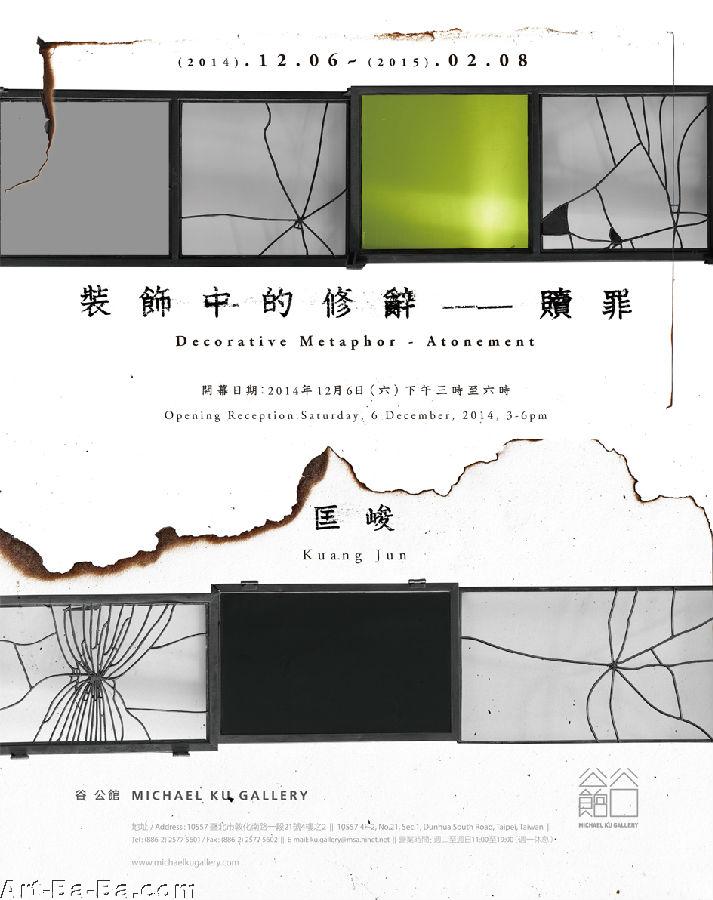
装饰中的修辞-赎罪
匡峻
展览日期:2014年12月6日(六) 至2015年2月8(日)
开幕日期:2014年12月6日(六)下午三时至六时
关于展览
谷公馆很荣幸宣布匡峻于台湾的首次雕塑个展《装饰中的修辞-赎罪》。展览为匡峻(UNMASK团员之一)2014年的新作,共三组作品组成:《装饰中的修辞-赎罪》、《允许为人-2》、《小燕子》。延续在UNMASK团体在雕塑作品中,对视觉语言及观念的讨论,匡峻首次的个人展出,更多的部分是着眼现代社会中的自我与时代建构的描绘。
三组雕塑作品的媒材,无论是从过去标准化共产时代被拆迁废弃房屋拆下的铁窗、现成的木制房梁或门框,或是创作的人型铜雕,匡峻都在创作的过程中使用了「破坏」与「修复」的动作。《装饰中的修辞-赎罪》捡拾了老铁窗框,用铜以雕塑手法再将破碎的玻璃拼凑,或用彩绘玻璃镶嵌;《小燕子》碳化木制化的门框与房梁后包裹紫铜,再将木碳挖出制成垂地的燕子形象;《允许为人-2》使用了古典雕塑语言的人像和台座,采用古代审美中铜包铁的工艺,在形象上、材质上、工艺技法上、展示呈现上选择古典的形式,却在身体几处位置镂空处理,让新与旧、华丽与黯淡共存。
这份「破坏」与「修补」因为创作的名义而变得合理。对于过去的某种信仰,如同1957年的电影《护士日记》插曲《小燕子》,春天的到来与信仰,那是对于新生活新建设的热爱。而反映在匡峻作品里的小燕子是今日剩下的昨日房梁。「修复」出自对物的尊重,既是正视过去的任性,也是在旧有的基底上重新创造。艺术家在作品名称的后方,加了「赎罪」一词,强调创作作品的过程与动机,也是匡峻雕塑作品中最重要的内在心性。匡峻在思考中国社会变迁,现代社会观察的母题,也同时是艺术家对于雕塑的本质、自我存在的本质与情感、艺术的本质所作的诸多探问。
关于匡峻
匡峻,2002年毕业于北京中央美术学院雕塑系,毕业后以团体UNMASK共同创作展出结合雕塑与设计概念的作品。2014年12月于台北谷公馆,匡峻首次以个人名义在台湾举办个展,其作品有延续UNMASK时的美学思考,也有自我探寻的议题。UNMASK曾获2007年AAC艺术中国年度青年艺术家奖,作品有古典雕塑的训练基础,在此之上不断尝试新的表现上与创意概念。2006年首次个展《UNMASK 2002-2006》即以破碎人像雕塑《半透明》系列提出一个新一代雕塑方式。此后,2009年《零度》(0°—UNMASK 2009)则更进一步在雕塑上运用材质混搭,创造出新的语言。2011年个展《血拼-shopping》,则用夸张戏谑的题材与造型,直指消费社会中荒诞的、疯狂的、不惜一切代价警示与批判。2011年《闪存》在造型的游戏上更上一层,在人与独角兽的形象之间取得了一个介于虚幻与真实、古典与当代的漂亮平衡。
关于谷公馆
谷公馆Michael Ku Gallery,坐落在台北市中心,成立于2008年的MICHAEL KU GALLERY,是台湾少数有着美术史背景训练的画廊业者,每档展览Michael Ku皆亲自策展并撰写展览文字。从开幕到现在一系列有规划地介绍新生代优秀艺术家,成为一个清晰的脉络体系的结合。并以文化推广的角度,为画廊创造一种具备独立精神与人文深度的视野,探讨在作品表面的背后的另一层次意境。
Decorative Metaphor – Atonement
KUANG JUN
Exhibition date:6 December, 2014 – 8February, 2015
Opening date:6 December, 2014, 3-6 pm
About Exhibition
MichaelKu Gallery is pleased to announce Kuang Jun’s first sculpture exhibition inTaiwan, Decorative Metaphor – Atonement.The show features the artist's latest works made in 2014 and comprises threesets: Decorative Metaphor–Atonement, Allowedto be Human 2 and Small Swallows. Extending discussions about visuallanguage and concepts found in sculpture works by UNMASK, the artists group towhich he belonged, Kuang Jun's first solo show stresses more on depicting theconstruction of one's self and of the times in the modern society.
The media of the three sets of sculptures rangefrom iron gratings dismantled from demolished abandoned houses of thestandardized communist period, ready-made wood beams or door frames, or bronzesculptures of human figures made by the artist. As diverse as the mediamay seem, Kuang Jun applies to each work the acts of “destruction” and “repair”in the process of making. For DecorativeMetaphor–Atonement, the artist collected used iron gratings andre-assembled shattered glass with copper through sculptural approaches orinlays the glass into mosaics. With Small Swallows, he carbonizes wooddoor frames and beams, wraps them in purple copper, digs out charcoal andcreates images of swallows dragged over the floor. For Allowed to be Human 2,he employs sculptures of humans and pedestals pertaining to the language ofclassic sculpture and applies the craft of iron wrapped in copper, a techniquedrawn from the aesthetics of the past. While the artist chooses the classicmanner to treat the figures, materials, craftsmanship and presentation of thispiece, he hollows out certain parts of the bodies, thus juxtaposing the new andthe old, the glamour and the gloomy.
Inthe name of creation, such “destruction” and “repair” are justified. A kind ofbelief in the past, like the song titled Small Swallows in the film NurseDiary(1957) about the advent of spring and the belief in it, it is aboutpassion for new life and new construction. And the Small Swallowsreflected in Kuang Jun's work are collapsed beams left from the past. “Repair”comes from one's respect toward objects; this is about the tenacity ofconfronting the past and about re-creating on the basis of previous bases. Theartist attaches the term “atonement” to the end of the title of each work,emphasizing the process and motivation of art-making. This also represents themost essential inner mentality in Kuang Jun’s sculptural oeuvre. Kuang Junreflects on the transformations of Chinaese society; the motif of observingmodern society also implies the artist's inquiries into the nature of sculpture,the essence and feeling of one's existence and the essence of art.
About KUANG JUN
Kuang Jun wasgraduated from Department of Sculpture, China Central Academy of Fine Arts in2002. He participates in UNMASK with works combining sculpture and designconcepts. His first solo exhibition in Taiwan will be held in Michael KuGallery in December 2014. These works continue aesthetic aspects in UNMASK anddive into self exploration.
UNMASK receives AAC Chinese Annual Young Artist Award in 2007. Its worksexplore new presentation and creative concepts based on classic sculpturetraining. The first exhibition, UNMASK 2002-2006, in 2006 proposes anext-generation sculpture model with fragmented figure Translucent series.0°—UNMASK 2009 further creates new languages with mixed materials insculpture. The 2011 exhibition, shopping, criticizes extravagant and ridiculousconsumerist society with exaggerative topics and forms. Flash Memory in 2011strikes a perfect balance between fantasy and reality, as well as classic andcontemporary.
About MichaelKu Gallery
Michael KuGallery was founded in 2008 in Taipei as one of a few galleries with solid arthistory background. Mr. Ku curates the exhibitions and also composes relatedtexts. The exhibition program involves both established and new Asian artists.In the past few years, we have introduced many Chinese, Japanese, andIndonesian artists to Taiwan market with solo exhibitions including Wei Jia,Jia Aili, Hu Xiaoyuan, and Ay Tjoe Christine. We are the first gallery inTaiwan to gather this group of exceptional young artists for discussion andexhibition. Meanwhile, the gallery thrives on a solid foundation in humanism,as it promotes Taiwanese artists including aesthetician Chiang Hsun, as well assome emerging younger generation installation and video artists.